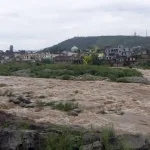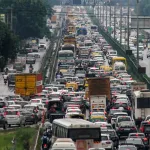Srinagar, with its intricate network of lakes, rivers, and canals, has always been prone to water logging and inadequate drainage systems. Every year, Srinagar grapples with the aftermath of heavy rains, which result in widespread water logging and flooding. The absence of a robust drainage infrastructure in Srinagar has far-reaching consequences for both the residents and the environment. During heavy rainfall or snowmelt, water accumulates on roads, causing severe traffic congestion and hindering emergency services. Moreover, water logging poses a serious threat to public health. Additionally, the damage caused to roads, buildings, and infrastructure due to water logging leads to substantial economic losses for the city. Over the years, the valley has witnessed erratic weather patterns, including intense rainfall and sudden temperature fluctuations. These climatic variations demand a drainage system capable of efficiently managing excessive precipitation. Furthermore, rapid urbanization has increased the amount of impermeable surfaces in the city, such as concrete roads and buildings, further exacerbating drainage issues. It is crucial to adapt to these changes by implementing sustainable and innovative drainage solutions. The government has been trying to upgrade the infrastructure, but progress has been slow and inconsistent. The city’s burgeoning population and rapid urbanization require a more proactive and comprehensive approach. The need of the hour is a well-planned, efficient, and resilient drainage system that can withstand the challenges posed by climate change and urban expansion. Implementing a modern drainage system is not a mere infrastructural upgrade; it’s an investment in the future of Srinagar. A robust system will not only mitigate flood risks but also enhance public health, improve the quality of life, and boost the city’s tourism potential. The government and the concerned authorities must invest in a comprehensive drainage master plan that accounts for the city’s unique topography, hydrology, and climatic conditions. This plan should prioritize the construction and maintenance of flashflood drains and culverts to effectively channel the excess water during heavy rainfall. Additionally, the use of permeable pavements and green spaces can aid in water absorption and reduce runoff. Efforts to improve the drainage system cannot succeed without the active involvement of the public. Awareness campaigns should be launched to educate citizens about the importance of responsible waste disposal and the adverse effects of clogged drains. Additionally, public participation in maintaining and monitoring the drainage infrastructure could help identify and address issues promptly. The administration must commit to investing in sustainable and innovative solutions tailored to the needs of the Srinagar city that can mitigate the consequences of water logging and pave the way for a more resilient and prosperous future. Let’s transform Srinagar into a city that is not just beautiful but also resilient, clean, and healthy. Let’s give the city the efficient drainage system it deserves and needs.
Efficient drainage system
Sign Up For Daily Newsletter
Be keep up! Get the latest breaking news delivered straight to your inbox.
By signing up, you agree to our Terms of Use and acknowledge the data practices in our Privacy Policy. You may unsubscribe at any time.
Leave a Comment Leave a Comment
Stay Connected
Latest News
Recent Posts
- Rs 3.79 cr relief disbursed in Rajouri post-heavy rainfall
- Police attach properties of proclaimed offenders, notorious drug peddler
- Kargil to host 10th Zanskar Festival on Sept 20-21
- Heavy rainfall aftermath: Non-functional traffic signals cause severe congestion in Jammu
- CSIR IIIM distributes 430 apiculture units under floriculture mission





